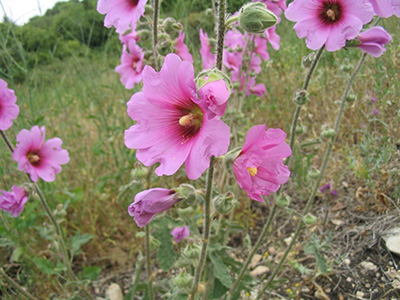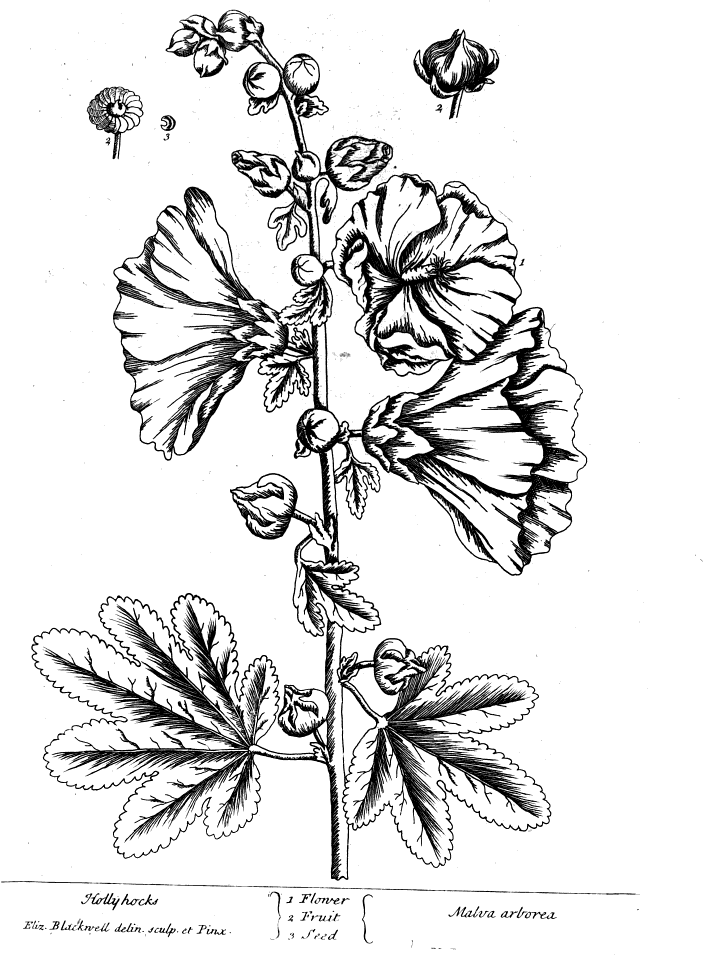Hollyhocks

Hollyhocks
Image source -
https://en.wikipedia.org/wiki/File:Alcea_setosa.jpg - lic. under CC

Other names for Hollyhocks, Past or Present
English - Alcea, Althea Rose, Hollyhock Flower, Malva, Malva Flower,
Rose Mallow, Garden Mallow
Latin - Malva hortensis, Alcea rosea, Althaea rosea, Malvae arboreae flos
German - Ernrosen
French - Malves de Jardin
Dutch - Stockroosen
Italian - Malva maggiore
Hollyhocks - Background & Uses
Native to Asia, Hollyhocks is a popular ornamental plant that thrives in dry environments.[1]
Hollyhocks has a history of use in various traditional medicinal systems. For centuries, healers have considered the plant to have demulcent, diuretic, and emollient properties.[2] In Medieval England, dried Hollyhocks blossoms were prepared as tea to soothe inflammation of the throat and mouth.
Hollyhocks is said to have been used by healers of the Wiccan tradition to relieve chest congestion and prevent kidney stones.[3]
In Ancient China, the herb was used for culinary purposes.[4]
In contemporary literature, Hollyhocks is described as being used to treat and and prevent respiratory disorders and digestive ailments. [5]In certain cases, the plant is reported to have had a soothing effect on mucous membranes. Hollyhocks is also considered to have been effective in treating irritable bowel disorder, hayfever, peptic ulcers, colic, bladder inflammation, emphysema, gastritis, bronchitis, and diarrhea.[6]
Also considered an aromatic, Hollyhocks is a common ingredient in home spa treatments and cosmetic products.[7]
Hollyhocks - Scientific Studies
Research into the potential medicinal benefits of herbs has determined that Malva hortensis (Hollyhocks) is similar in composition to Althaea officinalis (Marshmallow).[4]
Hollyhocks in old Herbals & Pharmocopœia
Elizabeth Blackwell's "A Curious Herbal" (1751): 1. This plant grows six or seven foot high; the leaves are a light green and the Flowers a pale Red. 2. It grows in Garden and flowers in July and August. 3. Hollyhocks are much of the Nature of the common Mallows, but less mollifying; they are mostly used in Gargles for the swelling of the Tonsils, and relaxation of the Uvula.
Hollyhocks Illustration

Hollyhocks
References:
[1] Hollyhocks: Index of Species Information. U.S. Department of Agriculture, Forest Service,
Rocky Mountain Research. https://www.fs.fed.us/database/feis/plants/forb/iliriv/all.html
[2] Grieve, Maude. A Modern Herbal. 1971. Dover Publications, Inc. Mineola, NY.
[3] Drew, A. J. A Wiccan Formulary and Herbal. 2005. The Career Press, Inc. Franklin Lakes, N.J.
[4] Lawton, Barbara Perry. Hibiscus: Hardy and Tropical Plants for the Garden. 2004. Timber Press, Inc. Portland, OR.
[5] Heatherly, Ana Nez. Healing Plants: A Medicinal Guide to Native North American Plants and Herbs. 1998. The Globe Pequot Press. Guilford, CT.
[6] Roberts, Margaret Joan. Edible and Medicinal Flowers. 2000. New Africa Books.
[7] Alcea. Wikipedia. https://en.wikipedia.org/wiki/Alcea
Main article researched and created by Kelsey Wambold - herbshealthhappiness.com 2013


1. Famous Chef Sheds 60lbs Researching New Paleo Recipes: Get The Cookbook FREE Here
2. #1 muscle that eliminates joint and back pain, anxiety and looking fat
3. Drink THIS first thing in the morning (3 major benefits)
4. [PROOF] Reverse Diabetes with a "Pancreas Jumpstart"
5. Why Some People LOOK Fat that Aren't
6. Amazing Secret Techniques To Protect Your Home From Thieves, Looters And Thugs
7. The #1 WORST food that CAUSES Faster Aging (beware -- Are you eating this?)
If you enjoyed this page:



























